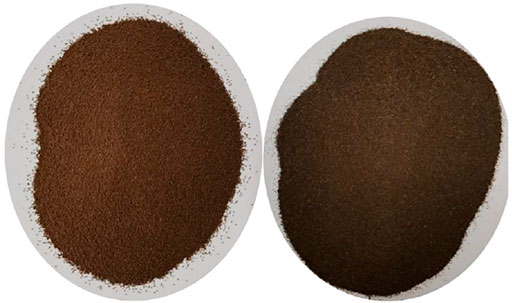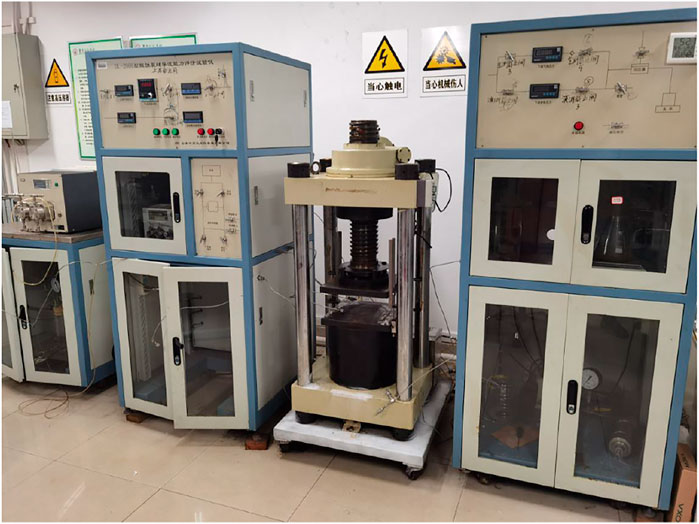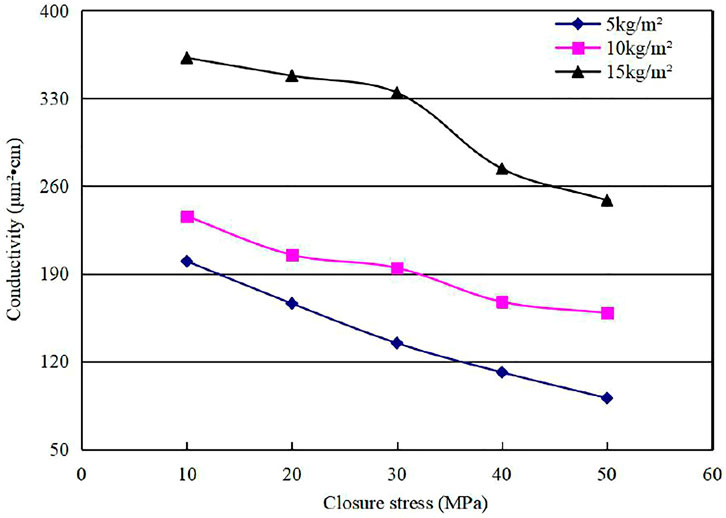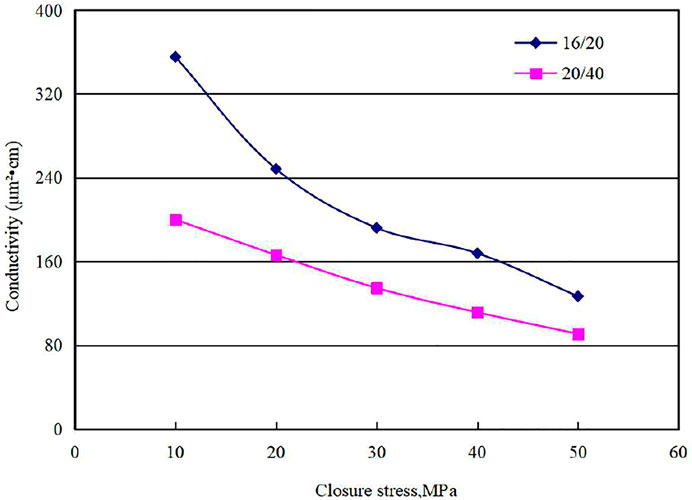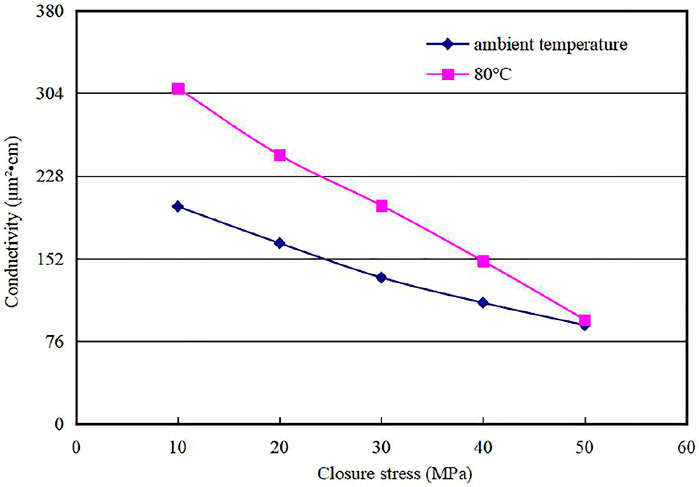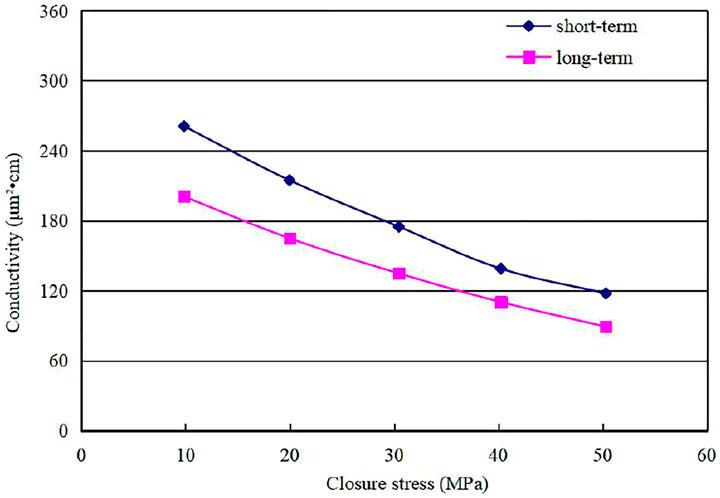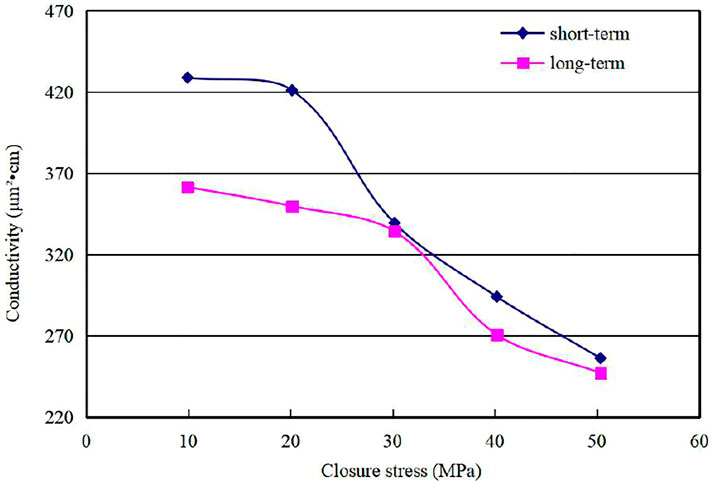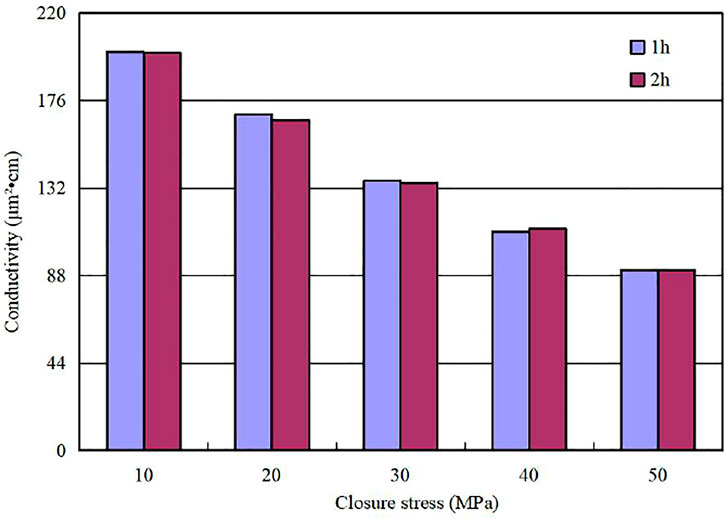- 1Department of Offshore Oil and Gas Engineering, School of Oil & Natural Gas Engineering, Southwest Petroleum University, Chengdu, China
- 2Department of Petroleum Engineering, School of Petroleum Engineering, Chongqing University of Science & Technology, Chongqing, China
Long-term conductivity data is essential to predict the production performance of the fractured well. It is necessary to know its long-term conductivity when choosing Tianxiang ceramic to prop hydraulic fractures in Northwest China. Its long-term conductivity was evaluated using DL-2000 equipment. Testing time at each closure stress point is more than 7 h, though the procedure used is similar to the recommended practice for short-term proppant conductivity. This test also investigates how factors such as proppant concentration and proppant size affected long-term conductivity. The results show these factors have a significant effect on long-term conductivity. Conductivity increases as proppant concentration rises, contributing to the increase of proppant volume and fracture height. Large proppants provide higher conductivity because large proppants have higher pore space and higher proppant pack height. High experimental temperature increases proppant conductivity due to dissolution and migration of minor fines and impurities. Besides, due to compaction, conductivity declines with the increase of testing time. Therefore, short-term conductivity is higher than long-term conductivity, while conductivity drops as testing time lasts. The results imply that Tianxiang ceramic performs as well as other ceramic proppants. It can offer proppant conductivity required by stimulation and qualifies to stimulate oil and gas wells in China. The achievements of this experiment will benefit hydraulic fracturing stimulation.
Introduction
There are a tremendous amount of oil resources in Northwest China. Some of these oil reservoirs need to be treated by hydraulic fracturing, which will increase the production rate of a producing well and improve oilfield economic performance. After hydraulic fracturing treatment, the better the proppant placement, the higher the oil production (Li et al., 2017; Xiao et al., 2020; Jun et al., 2021a; Jun et al., 2021b; Li et al., 2021). Besides, the producer and technical service provider need to assess the production performance of a treated well and appraise the effect of the fracturing treatment. Basic parameters such as proppant conductivity need to be prepared when evaluating the production performance of the fractured well. Proppant conductivity is usually divided into short-term conductivity and long-term conductivity. Short-term conductivity refers to conductivity values in which testing time lasts shorter at each pressure point. Long-term conductivity refers to conductivity values in which testing time lasts longer than 7 h at each pressure point. Here the proppant conductivity refers to long-term conductivity. Long-term conductivity data are usually unavailable because they take a lot of money and time to obtain. However, long-term conductivity data are necessary to predict post-fracturing production performance. Tianxiang ceramic proppant is widely applied to stimulate oil reservoirs in Northwest China. Therefore, its long-term conductivity data should be offered. This paper will provide long-term conductivity data of Tianxiang ceramic which is applied to stimulate oil wells in Northwest China.
The petroleum industry and associated universities have made significant progress in the research area of long-term proppant conductivity (Mittal et al., 2018; Abhinav et al., 2020; Roman et al., 2021). Mingjun et al. developed a new apparatus to measure long-term proppant conductivity (Mingjun et al., 2010). This facility could simulate closure stress up to 100 MPa and keep closure stress constant for more than 300 h. Researchers tended to use long-term conductivity data to assess the performance of new proppants. Hongjun et al. developed a new ceramic proppant and presented its long-term conductivity data (Hongjun et al., 2011). Kaiquang also studied the long-term conductivity of a new proppant (Kaiqiang, 2017). The long-term conductivity of resin-coated proppant decreased sharply during the early 7 h and then decreased slightly (Wanglai et al., 2007).
Moreover, resin-coated proppant gave lower long-term conductivity values than short-term conductivity 7 h later. It was also found that the coating of coated proppant suffered severe damage. Shucai and Yi et al. published experimental results of long-term conductivity of typical proppants (Yi et al., 2004; Shucai, 2016). Shucai restricted proppant concentration to 10 kg/m2, which would not happen in most cases. Yi’s work showed how long-term conductivity of common proppants changed and suggested that long-term conductivity could be improved by using low crushing rate proppants, reducing the content of small particles and increasing proppant concentration (Yi et al., 2004). Some researchers investigated the effect of proppant embedment and combined proppant with different particle sizes on long-term conductivity. Lei et al.‘s work implied that there existed a maximum conductivity value when different-particle-size proppants were combined into composite proppant (Lei and Shicheng, 2005). He also found that small-size proppant harmed long-term conductivity of composite proppant. A scholar named Qingzhi concluded that embedded damage was related to closure stress, proppant concentration, and rock type (Qingzhi and Shicheng, 2005). As for proppant choice, Yanxue et al. proposed an optimization method that took into account stress sensitivity and long-term proppant conductivity (Yanxue and Yongli, 2004). Long-term conductivity is needed when post-fracturing performance is evaluated after a well is stimulated. However at the moment, long-term conductivity data about Tianxiang ceramic is not available. Published conductivity data were conducted with other ceramic proppants under conditions of certain pressure, specific temperature, and proppant concentration. Experimental work must be undertaken to assess proppant used in oilfields, Northwest China, because long-term conductivity data published were gained with specific proppants under specific conditions.
This article first presents the conductivity experiment principle and then introduces the materials and equipment concisely. After that, we describe the experimental procedure in detail. Thirdly we show experimental results and analyze how proppant type, proppant concentration, proppant size, and testing time affect long-term conductivity. Finally, we compare our results with published data and suggest how to improve long-term conductivity of hydraulic fracturing proppant. The results imply that Tianxiang ceramic performs as well as other ceramic proppants. Therefore, it can offer proppant conductivity required by stimulation treatment and qualifies to stimulate oil and gas wells in China.
Theory
When liquid flows through the proppant pack, it satisfies Darcy’s law. Taking into account the dimension of the cell, the conductivity value could be calculated using Eq. 1.
where Wfk is the proppant pack conductivity in μm2·cm, Wf is the length of the proppant pack in cm, k is the permeability of the proppant pack in μm2, Q is the flow rate through the pack in cm3/min, μ is the liquid viscosity in mPas, and Δp is the pressure differential through the pack in kPa.
When distilled water or deionized water flows through the proppant pack, the apparatus will record liquid flow rate, pressure differential, and experimental temperature. The viscosity of distilled water is known by checking the viscosity table of distilled water according to recorded temperature, and then conductivity value could be calculated using Eq. 1.
Materials and Equipment
The assessment used distilled water as the testing fluid. The proppant tested is called Tianxiang ceramic which is manufactured in central China (Figure 1). It included two sizes, namely 16/20 mesh and 20/40 mesh, respectively. They are gray, and they have good physical properties such as density, roundness, sphericity, acid solubility, and crush rate.
The apparatus used during the assessment was the DL-2000 fracture conductivity evaluation instrument (Figure 2). Its key part is a standard conductibility cell. The cell can be exerted axial load up to 150 MPa. The test fluid is supplied by a constant pressure and constant flow rate pump and flow rate can vary from 0.1 ml/min to 1,000 ml/min. When test fluid flows through the proppant pack, the differential pressure is recorded by a differential pressure transmitter for which maximum value is 10 kPa. This apparatus has the qualification to test short-term and long-term conductivity of hydraulic fracturing proppant. Its control system can keep closure stress constant for more than 300 h which satisfies the need to test long-term proppant conductivity. It can also perform proppant-flow back-test which will determine the critical production rate without sand production.
Procedure
There is no petroleum industry standard for measuring long-term proppant conductivity in China though there is a latest industry standard for assessing short-term proppant conductivity which had been published in 2019 (SY/T 6302-2019). The recommended practice was just modified to evaluate long-term proppant conductivity.
When conducting a long-term conductivity test, the following experimental procedure was taken. Firstly, pressure gauges and the linear variable displacement transducer were calibrated and the curtain mass of proppant was prepared; secondly, the core holder, namely the API (American Petroleum Institute) cell, was assembled and the differential transducer was calibrated; thirdly, closure stress was elevated to 10 MPa, the cell was heated to target temperature, and the proppant pack was let stable for 45 min; next, distilled water flowed through the proppant pack and the differential pressure and the flow rate were recorded for 5 min with the flow rate of 2.5ml/min, 5.0ml/min, and 10 ml/min respectively; then the pack was continuously allowed to stabilize for 45 min and again the differential pressure and the flow rate were recorded for 5 min with the flow rate of 2.5ml/min, 5.0ml/min, and 10 ml/min respectively; this process lasted for 7 h before elevating closure stress to next value; after that, closure stress rose to next test point in increments of 10 MPa and the testing process was repeated till closure stress reached to 50 MPa; finally, the test ended and the data were processed.
Results and Discussion
Figure 3 shows the relationship between long-term conductivity and proppant concentration at ambient temperature. Conductivity data was gained at ambient temperature if not specified. The long-term conductivity of 20/40 ceramic increases as proppant concentration rises. The 15 kg/m2 ceramic provides the highest conductivity, while the 5 kg/m2 ceramic has the lowest. Conductivity with 10 kg/m2 ceramic is higher than that with 5 kg/m2 ceramic and lower than that with 15 kg/m2 ceramic. At closure stress of 10 MPa, proppant conductivity at the concentration of 15 kg/m2 is 53% higher than that at the concentration of 10 kg/m2.
In contrast, proppant conductivity at the concentration of 5 kg/m2 is only 84.5% of that at the concentration of 10 kg/m2. This agrees with Qingzhi’s conclusions. Qingzhi concluded that proppant conductivity increased as proppant concentration rose (Qingzhi and Shicheng, 2005). When proppant concentration increases, proppant volume increases. Consequently, at the same cell area the pack’s height rises, which would lead to higher conductivity. Proppant pack of 15 kg/m2 ceramic has maximum proppant height, proppant pack of 15 kg/m2 ceramic has minimum proppant height, and proppant pack of 10 kg/m2 ceramic has medium proppant height which leads to the difference of testing results. From this point, a conclusion can be made that proppant concentration should be increased as high as possible during hydraulic fracturing treatment to increase the production rate of the fractured well substantially.
The experiment compared conductivities of different proppant sizes. Figure 4 presents the results. It shows that large ceramic offers higher conductivity than a small one. In other words, 16/20 ceramic can provide a higher conductivity than a 20/40 one. Large proppants provide more pore space and higher proppant pack height than small ones. More pore space means higher permeability which would offer higher conductivity according to the definition of the conductivity. This suggests that hydraulic fracturing should try to choose a large proppant if fracture closure stress allows to do so.
The effect of experimental temperature on long-term conductivity is shown in Figure 5. The higher the temperature, the higher the conductivity. The gap is remarkable at low closure stress, whereas it becomes smaller as closure stress rises. This disagrees with Wen’s work (Wen, 1998). Wen found that formation temperature would lower proppant conductivity. In this study, the proppants used in the measurement might contribute to the opposite result. They are not sieved and consisted of some fines and impurities. These substances will lower proppant conductivity under ambient temperature because they occupy some pore space. However, these substances may dissolve in experimental fluid and be removed under high temperature which certainly increases proppant conductivity. When closure stress elevates, the gap of proppant conductivity becomes smaller due to compaction. This result implies that formation temperature may sometimes positively affect proppant conductivity.
The experimental results indicate that long-term conductivity is always lower than short-term conductivity regardless of proppant concentration (shown in Figure 6 and Figure 7). The difference between long-term conductivity and short-term conductivity is enormous at low closure stress, and it becomes smaller as closure stress increases. This agrees with published literature. They all concluded that long-term conductivity is more minor than short-term conductivity (Yi et al., 2004; Wanglai et al., 2007; Hongjun et al., 2011; Shucai, 2016; Kaiqiang, 2017). Closure stress will exert on the cell longer during the long-term conductivity measurement which would strengthen compaction effect. It is known that the compaction can reduce the height of the proppant pack and the pore volume of the proppant pack which undoubtedly leads to lower conductivity. This conclusion confirms that the production performance of the fractured well should be predicted using long-term conductivity data. Figure 6 is a typical comparison diagram between short-term conductivity and long-term conductivity and strengthened compaction contributes to this trend. For Figure 7, the movement is out of expectation. The conductivity gap is tiny at the medium closure stress range. Crush rate at high proppant concentration may rise rapidly and proppant pack produce many proppant fines which severely damage proppant conductivity. Those fines cause proppant conductivity to decline rapidly.
Figure 8 and Figure 9 show the effect of testing time on ceramic conductivity. On the whole, the conductivity decreases as the testing time lasts. This agrees with Figure 6 and Figure 7. It also agrees with other researchers’ work. They concluded that long-term conductivity and short-term all declined as testing time lasted (Yi et al., 2004; Wanglai et al., 2007; Hongjun et al., 2011; Shucai, 2016; Kaiqiang, 2017). As testing time lasts, it becomes longer that stress closure exerts on the cell. The stress will compact the proppant pack further and lower proppant pack permeability and proppant pack height which leads to low conductivity. It is already speculated and confirmed that conductivity would decrease as testing time is prolonged. As for 16/20 mesh ceramic, the conductivity value is abnormal at 10 MPa. One possible reason is the introduction of fines and impurities. When the measure started, these substances moved and caused damage to the proppant pack. Therefore proppant should be qualified to satisfy the industry standard.
Conclusion
This article assessed long-term conductivity of Tianxiang ceramic and analyzed how these factors, such as proppant concentration, proppant size, etc., affected conductivity. Proppant concentration, proppant size, experimental temperature, and testing time significantly affect proppant conductivity. Conductivity increases sharply as proppant concentration rises. High proppant concentration means high height of the proppant pack, resulting in higher conductivity. It is suggested that proppant concentration should increase possibly during the treatment. Large proppants offer higher conductivity than small ones. Large proppants have more pore space, and therefore proppant pack provides higher permeability that indeed leads to higher conductivity. It suggests that operators try to choose large proppant if allowed. An opposite conclusion is made about the effect of temperature on conductivity. It is thought that the introduction of fines and impurities possibly causes this phenomenon. Conductivity will decline as testing time lasts. Compaction can contribute to this. It reduces the height of the proppant pack and the pore volume of the proppant and consequently results in lower conductivity. So some measures must be taken to assure proppant quality on the site.
Data Availability Statement
The original contributions presented in the study are included in the article/supplementary material, further inquiries can be directed to the corresponding author.
Author Contributions
JW wrote this paper, GJ analyzed the experimental results and DL offered experimental data.
Conflict of Interest
The authors declare that the research was conducted in the absence of any commercial or financial relationships that could be construed as a potential conflict of interest.
Publisher’s Note
All claims expressed in this article are solely those of the authors and do not necessarily represent those of their affiliated organizations, or those of the publisher, the editors and the reviewers. Any product that may be evaluated in this article, or claim that may be made by its manufacturer, is not guaranteed or endorsed by the publisher.
Acknowledgments
The authors of this article would like to thank Shifang Ma for her experimental data. The authors would like to thank Chongqing University of Science and Technology for permission to publish this article.
References
Abhinav, M., Chandra, S. R., and Carl, H. S. (2020). Proppant-Conductivity Testing under Simulated Reservoir Conditions: Impact of Crushing, Embedment, and Diagenesis on Long-Term Production in Shales. SPE J. 23 (04), 1304–1315. doi:10.2118/191124-PA
Hongjun, D., Dongping, L., and Shifeng, X. (2011). Analysis and Application of Long-Term Conductivity of a New Ceramic Proppant. China Pet. Chem. Stand. Qual. 31 (12), 86. doi:10.3969/j.issn.1673-4076.2011.12.066
Jun, L., Mingyi, W., and Lihua, Zh. (2021). A New Proppant Type Fully Coupled Fiber-Proppant and its Property Evaluation for Unconventional Reservoirs. J. Pet. Sci. Eng. 109573, 0920–4105. doi:10.1016/j.petrol.2021.109573
Jun, L., Shibo, K., and Zheng, Q. (2021). Experimental Investigation of the Leak-Off Effect on Proppant Transportation and Distribution in a Vertical Fracture. J. Nat. Gas Sci. Eng. 104358, 1875–5100. doi:10.1016/j.jngse.2021.104358
Kaiqiang, Zh. (2017). Analysis and Application of Long-Term Conductivity of a New Proppant. Chem. Eng. Equipment 1 (03), 47–49. CNKI:SUN:FJHG.0.2017-03-017.
Lei, W., and Shicheng, Zh. (2005). Experimental Research on Long-Term Conductivity of the Proppant Combination with Different Grain Sizes in Complex Fracture. Nat. Gas Industry 25 (9), 64–66. doi:10.3321/j.issn:1000-0976.2005.09.021
Li, J., Liu, P., Kuang, S., and Yu, A. (2021). Visual Lab Tests: Proppant Transportation in a 3d Printed Vertical Hydraulic Fracture with Two-Sided Rough Surfaces. J. Pet. Sci. Eng. 196, 107738. doi:10.1016/j.petrol.2020.107738
Li, N., Li, J., Zhao, L., Luo, Z., Liu, P., and Guo, Y. (2017). Laboratory Testing on Proppant Transport in Complex-Fracture Systems. SPE Prod. Operations 32, 382–391. doi:10.2118/181822-pa
Mingjun, Zh., Xianfeng, C., and Jinhai, H. (2010). Development the Instrument for Measuring Long- Term Diversion Capacity of the Propping Agent Fracture. Chian Pet. Machinery 38 (3), 41–42. CNKI:SUN:SYJI.0.2010-03-014.
Mittal, A., Rai, C., and Sondergeld, C. (2018). Experimental Proppant Conductivity Observations: Evaluating Impact of Proppant Size and Fluid Chemistry on Long-Term Production in Shales. In Presented at the SPE Hydraulic Fracturing Technology conference, September 24. Dallas, Texas, USA: the SPE Annual Technical Conference and Exhibition–26. doi:10.2118/191741
Qingzhi, W., and Shicheng, Zh. (2005). Influence of Proppant Embedment on Fracture Long-Term Flow Conductivity. Nat. Gas Industry 25 (5), 65–68. doi:10.3321/j.issn:1000-0976.2005.05.021
Roman, V., Galina, M., Vladimir, R., and Alexey, Y. (2021). Accuracy and Uncertainty Evaluation of Measuring the ISO Long-Term Conductivity of Proppants. In Presented at the SPE Annual Technical Conference and Exhibition. Dallas, Dubai, UAE. doi:10.2118/205940-MS
Shucai, S. (2016). Test and Evaluation of Long-Term Proppant Conductivity. Shandong Ind. Techn. 1 (19), 241. doi:10.16640/j.cnki.37-1222/t.2016.19.209
Wanglai, G., Shunli, H., and Jinli, J. (2007). Evaluation on Long-Term Flow Conductivity of Coated Proppant. Nat. Gas Industry 27 (10), 100–102. CNKI:SUN:TRQG.0.2007-10-034.
Wen, Zh. (1998). Quantitative Evaluation of Reservoir Temperature and Yong’s Modulus of Rock on Proppant Pack Conductivity. Oil Drilling Prod. Techn. 20 (4), 59–61. CNKI:SUN:SYZC.0.1998-04-014.
Xiao, H., Li, Z., and He, S. (2020). Experimental Study on Proppant Diversion Transportation and Multi-Size Proppant Distribution in Complex Fracture Networks. J. Pet. Sci. Eng. 196 (6), 107800. doi:10.1016/j.petrol.2020.107800
Yanxue, J., and Yongli, W. (2004). Optimum Seeking Method of Proppant in Consideration of Stress Sensitivity and Long-Term Flow Conductivity. Drilling Prod. Techn. 27 (5), 75–76. doi:10.3969/j.issn.1006-768X.2004.05.027
Keywords: assessment, long-term conductivity, proppant, oil well, hydraulic fracturing
Citation: Wang J, Xiong Y, Jiao G and Lei D (2022) Assessment of Long-Term Proppant Conductivity. Front. Energy Res. 10:813571. doi: 10.3389/fenrg.2022.813571
Received: 12 November 2021; Accepted: 24 January 2022;
Published: 25 February 2022.
Edited by:
Qi Zhang, China University of Geosciences Wuhan, ChinaReviewed by:
Yulong Zhao, Southwest Petroleum University, ChinaWeijun Shen, Institute of Mechanics (CAS), China
Copyright © 2022 Wang, Xiong, Jiao and Lei. This is an open-access article distributed under the terms of the Creative Commons Attribution License (CC BY). The use, distribution or reproduction in other forums is permitted, provided the original author(s) and the copyright owner(s) are credited and that the original publication in this journal is cited, in accordance with accepted academic practice. No use, distribution or reproduction is permitted which does not comply with these terms.
*Correspondence: Guoying Jiao, amlhb2d1b3lpbmdAY3F1c3QuZWR1LmNu
 Jun Wang1,2
Jun Wang1,2 Guoying Jiao
Guoying Jiao Dengsheng Lei
Dengsheng Lei